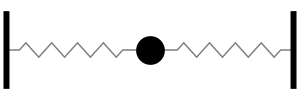Multiple Degree-of-Freedom Mass-Spring Systems
1-DOF Mass-Spring System

A single-degree-of-freedom mass-spring system has one natural mode of oscillation.
One mass connected to one spring oscillates back and forth at the frequency ω=(s/m)1/2.

One mass, connected to two springs in parallel, oscillates back and forth at the slightly higher frequency ω=(2s/m)1/2. The natural frequency is slightly higher (more oscillations per second) because the parallel springs combination has a greater stiffness than a single spring. (NOTE: the springs are in parallel - not in series - because they experience the same displacement, but not the same force).









